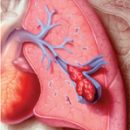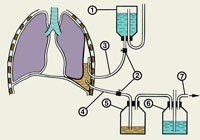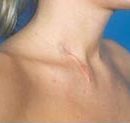Since the Hippocratic, the accumulation of purulent exudate in an anatomically legged cavity is called emphasis. Empony of the pleura is sometimes called purulent pleurrites, since the causes of their occurrence and the mechanism of development are almost identical. Read more in the article.
Content
Empiama pleura
 Empiama Plevra (purulent pleurisy, piotorax) - Magnica in the pleural cavity with the secondary compression of the pulmonary fabric. Direct path of penetration of infection; Lung injury, breastwall injury, esophageal rupture (post-traumatic empieme), pneumonia, tuberculosis, abscess or lung gangrene, bronchiectase, light resection, pneumothorax. Most frequent steam and metapneumonic empynesses. An indirect path of penetration of infection: subdiaphragmal abscess, acute pancreatitis, liver abscesses, inflammation of soft tissues and bone skeleton. Pathifiers: Staphylococci, Pneumococci, Optional and bonde anaerobes (Sinenny wand). As a result of inflammation, hyperemia and leukocyte infiltration of pleural leaves occurs, further the deposition of fibrin, clinically manifested by the appearance of the noise of the friction of the pleura and pains disappearing with the continuing accumulation of fluid in the pleural cavity. Gradually, the pleural sheets are thickened, the moorings are formed, contributing to the organization of an empieme cavity, one- or bilateral, limited either total, more often located basal, less frequently paramediable.
Empiama Plevra (purulent pleurisy, piotorax) - Magnica in the pleural cavity with the secondary compression of the pulmonary fabric. Direct path of penetration of infection; Lung injury, breastwall injury, esophageal rupture (post-traumatic empieme), pneumonia, tuberculosis, abscess or lung gangrene, bronchiectase, light resection, pneumothorax. Most frequent steam and metapneumonic empynesses. An indirect path of penetration of infection: subdiaphragmal abscess, acute pancreatitis, liver abscesses, inflammation of soft tissues and bone skeleton. Pathifiers: Staphylococci, Pneumococci, Optional and bonde anaerobes (Sinenny wand). As a result of inflammation, hyperemia and leukocyte infiltration of pleural leaves occurs, further the deposition of fibrin, clinically manifested by the appearance of the noise of the friction of the pleura and pains disappearing with the continuing accumulation of fluid in the pleural cavity. Gradually, the pleural sheets are thickened, the moorings are formed, contributing to the organization of an empieme cavity, one- or bilateral, limited either total, more often located basal, less frequently paramediable.
Complications. Perforation inside with the formation of bronchiploral fistulas, less often, through intercostal intervals - Magnifice in soft tissues of the chest wall (EMPyema undecessitatis), septicopemia.
Symptoms of empya pleura
The clinical picture is masked by the symptoms of pneumonia, therefore, with metapneumonic empynesses, its signs after a light gap are recognized easier than with postpnemonic emphas, shaped current pneumonia. Also determine the shortening of the percussion sound, the disappearance of respiratory noise, weakened voice trembling. X-ray study stands out the basal dimming with a horizontal level at a rotary infection or bronchoploral fiction - popurnum. Redness of the skin is observed only at a breakthrough of a pus from an empieme cavity under the skin. The general condition is progressively deteriorating as a result of the resulting purulent resorbative fever: weakness, loss of appetite, weight loss, hectic temperature, frequent pulse, high leukocytosis with a shift of the formula to the left, hypo-and disproteinemia.
Treatment of empya pleura
Already at the beginning of the treatment of patients with pneumonia, complicated by pleural efforts, it is necessary to anticipate the possibility of the development of purulent pleuritis, so the rational selection of antibiotics and timely drainage of the pleural cavity is necessary. Selection of antibiotics are carried out by analyzing sputum with color by gram. According to the results, the color is chosen by the corresponding antibiotics, the early use of which contributes to the absorption of pleural effusion. The decision on the drainage of the pleural cavity is made on the basis of an assessment of the species obtained under the pleural puncture of the liquid. The presence of pus serves as an imperative indication to drainage along the puncture needle using a trochar, through the lumen of which the drainage tube is introduced connecting to the BULUU system. Through the drainage tube, the empieme cavity is washed with antiseptics with the subsequent introduction of the daily dose of antibiotics. Emphama Plevura is especially dangerous in elderly and persecuted pneumonia delayed. Hospitalization Emergency to Surgical Branch Even when suspected ampime pleura.
Forecast for timely treatment favorable.









